St Andrews Primary is a rural school in South Canterbury where children and teachers have strong ties to their natural environment. They’ve recently become a Kiwibank Predator Free School – but that’s just the latest in an impressive lineup of conservation projects ranging from monitoring endangered mudfish to helping orphaned and injured harrier hawks and falcons.
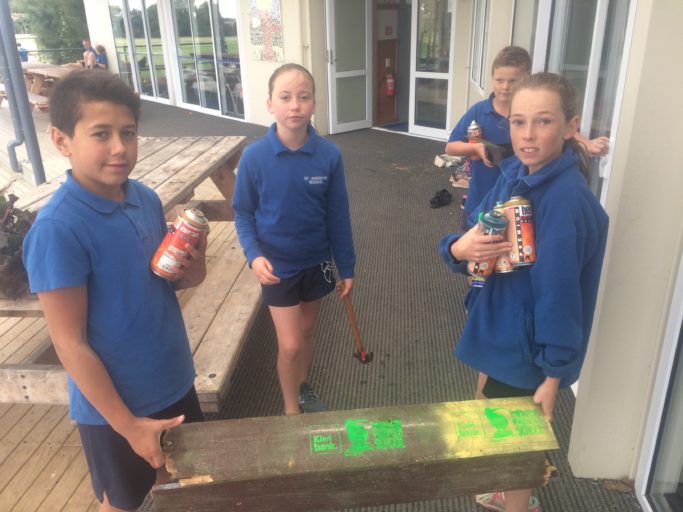
“We are the Kaitiaki of our local Canterbury mudfish and undertake annual monitoring and planting days,” says teacher Vaughan Skea. “We are also affiliated with The New Zealand Raptor Trust who we support through mufti days and by sourcing food through trapping and hunting of pests.”
So what exactly is a mudfish? The children explain:
“Mudfish are galaxiids,” says Jessica Box. “There are five types of galaxiids in New Zealand. They are little freshwater fish. They have one fin on each side at the front at the back they have one fin at the one on the bottom and one on the tail.”
They’re a local fish species and becoming endangered.
“They used to live in a widespread area from about Oxford south to the southern banks of Waitaki River,” explains Murphy Porter. “They are beginning to become endangered because people are destroying their natural wetlands, draining rivers and ponds. They are found in swampy lowland habitats like wetland, pools in swamp forests and slow flowing streams and drains.”
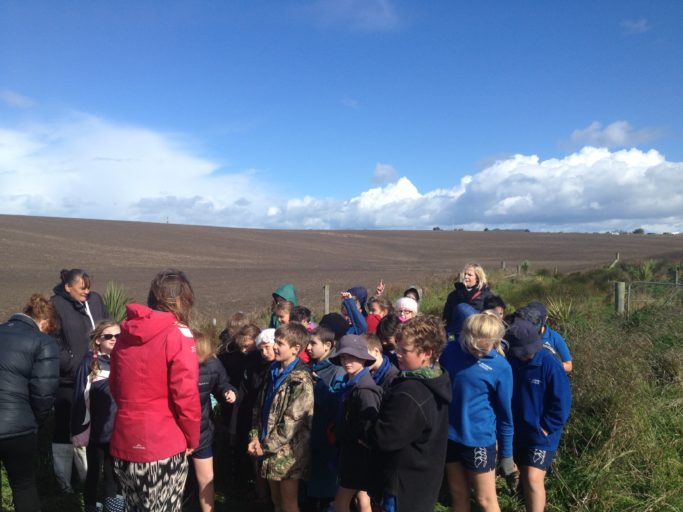
Mudfish have some pretty special survival skills, however.
“Black mudfish are unique in New Zealand,” says Cooper. “They occur in wetlands, swampy streams, small waterways and drains that become seasonally dry. They can survive out of water, sometimes for several months. Mudfish vary in size between species, but adults grow to around 9-12 cm long. Some of the largest mudfish found have been up to 17.5 cm long in length.”
Jessica Box explains what mudfish do when their waterway dries up.
“The scientific name for mudfish is Neochanna burrowsius. During drier periods, mudfish simply will dig deep and wiggle into the soil and hang in the trough waiting for wetter and wetter times to come. They are able to dig deep due to strengthened bones in their head and flattened shape of their skull, making them perfectly adapted to shovel down into the moist soil to rest until it gets wet again.”
Angus Collins and Murphy Porter explain why mudfish need help.
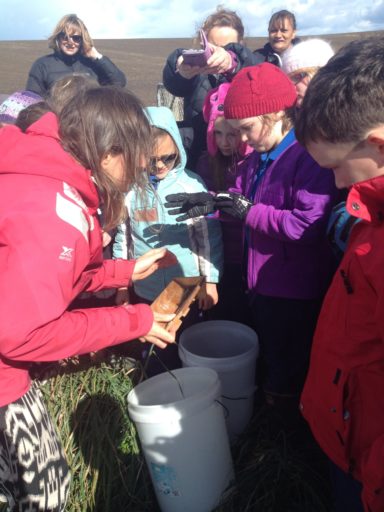
“Mudfish need help because they are endangered. They are endangered because one of the major threats to mudfish is habitat modification. Wetland drainage, land clearance, and modification of streams and drains decreases available habitat. And people drain their wetlands and poison their ponds so they are slowly becoming endangered.”
“Mudfish need help because farmers are draining water holes,” says Harlem. “That means they are running out of places to live and breed more mudfish. Also there are not many mudfish left over. Also they are endangered species because eels etc are eating them so it’s hard to breed them.
As Kaitiaki of their Canterbury mudfish, the children are doing what they can to monitor mudfish numbers and help their survival.
“We are keeping track of the mudfishes every second year, checking on the population and the size,” says Miles Linton. “We also see if there are some eels, then we will have to exterminate them because it is a threat to the mudfish.”
“We help the mudfish by setting eel traps around the area because the sea is right by the mudfish site. The river flows straight from the sea to the mudfish,” explain Angus Collins and Murphy Porter. “Sometimes we set live catching traps for the mudfish, with marmite as the bait. Then we get them and measure to see how big they are if they are really big it means they have been eating a lot, if they are really small they have either just been born or they haven’t eaten much.”
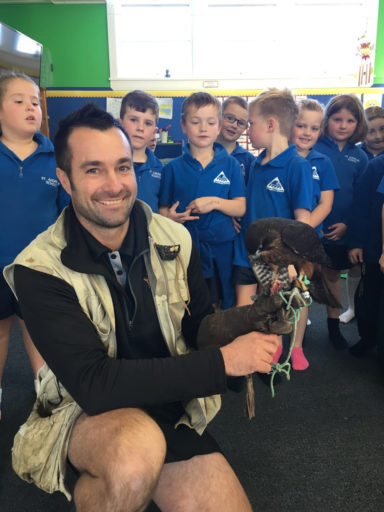
With experience already in trapping eels and monitoring mudfish, the children of St Andrews Primary already have some of the skills they’ll need for monitoring and trapping introduced mammal predators. What’s more they have some hungry raptors keen to eat any mammal pests they catch.
“Mr Skea, our teacher, has a trust called the Raptor Trust,” explains Miles Linton. “He rehabilitates and helps hawks, falcons etc. He also feeds the sick falcons and hawks. He has helped over seventy raptors and set free about twentyish falcons and hawks. He has also been on Fananimals.”
So why do raptors need help?
“Raptors usually need help because they get hit by cars or fly into windows,” says Angus Collins, “So Raptors Trust takes them in to take great care of them, because they could have broken their wing or they could be blind or be dumped from their parents. The raptors come from all over in South Canterbury. So that’s why Raptor Trust helps.”
“Raptor Trust is helping the hawks, raptors etc to live and to keep them safe,” says Harlem. “They also try to choose what’s best for them like giving them the blue juice (euthanasia) or getting them fixed up and ready to get back on the road again.”
Inspired by Mr Skea’s work, the children and their families are doing what they can to help raptors too.
“We are helping raptors by bringing in dead pests in to give to Mr Skea to feed to the raptors,” explain Syesha and Lucy. “Sometimes the kid’s parents bring in orphaned raptor chicks and eggs. We do fundraisers and farmers let them fly in their paddocks. The Raptor Trust has helped 70 and set 20 free.”

“We are helping raptors by providing food like possums, rabbits and pigeons. We also do fundraisers and people give donations. We are helping raptors by keeping them safe, and by keeping them until they are recovered and keeping them safe from getting injuries,” explain Murphy Porter and Jessica Box.
Now that St Andrews Primary is a Kiwibank Predator Free school, those rescue raptors may have pest-meat on their menu. The children talk about their plans for using their Kiwibank grant and the work they’ve already done.
“Thanks to Kiwibank Predator Free for giving us $1000, we have been spending the money on traps like A24, victor pro mouse trap, t-rex trap and the trapinator. We will be setting them up around the school and hope to catch predators that roam around the school. We also have built boxes to place the traps in, so if some little kids think they should touch it they will not be able to,” explain Jessica Box and Murphy Porter.
“As a Kiwibank predator free school we are already making tunnels and setting traps to catch predators around our school,” says Lydia Cleghorn. “When we catch the predators we are donating them to the New Zealand Raptor Trust so that the raptors will have food. We also have been planting native trees around our school and we are getting 100 more native trees in June to plant around our school, so we are a native school. We are also working on making trap designs for young inventors so that they can trap by themselves safely.”
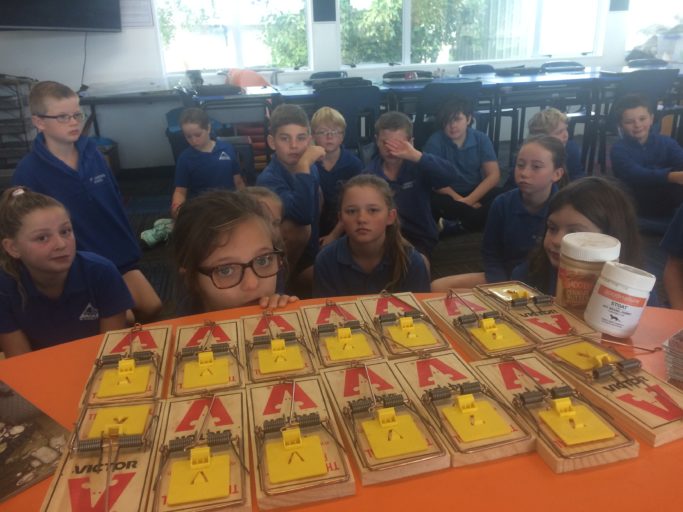
Waste Management, Timaru has previously donated trees to St Andrews Primary has and they are about to receive a further 100 trees from ‘Trees That Count’.
The children have already been checking out what introduced predators live in and around their school.
“We have discovered that we have rats, mice and hedgehogs around the school,” report Jessica Box, Angus Collins and Murphy Porter. “We figured that out by using tracking tunnels with ink in them to see their footprints and we now trying to get them in our traps which are A24, t-rex trap, victor pro and the trapinator.”
“So far we have caught some mice and rats in our traps and we are hoping to get some more,” says Lydia Cleghorn. “We have discovered a big hole in the back of our chicken coop from big rats digging through and harassing our chickens. So we are going to set up an A24 in the chicken coop where the hole is, hoping we will be able to catch the big rat. After we have caught the rat we are going to fill the hole back up hoping there will be no more rats going into the chicken coop and harassing the chickens.”
Lydia reckons peanut butter will catch the chicken coop rat and other predators.
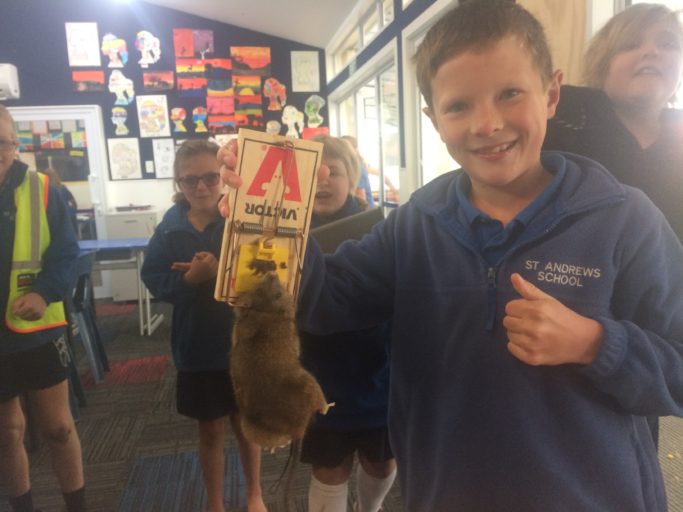
“I personally think that peanut butter might be a good bait because as a class we split into five groups and we got a tracking tunnel and an ink card and we got to put it in a place we thought we would get prints, and we used peanut butter. If we wanted to we could change the bait,” Lydia says, “But a lot of the groups used peanut butter and we got tracks. So after we knew what predators were in our school we got into different groups and we decided on what traps we were going to buy to kill the predators in our school. On 8th and 9th May we have been making trapping tunnels so we can put our traps we ordered inside and hopefully trap some predators.”
“My family does do a little bit of trapping down in our garage because we have had rats coming into the garage and chewing on the cabinets,” says Lydia Cleghorn, “So my Step-Dad has put some modified victor rat traps down there and we have caught about seven rats so far but they have only babies so we are hoping that we will catch the mother rat. We haven’t been trapping any rats or mice right now because we can’t find our traps, so we are going to get some different traps. We are thinking about buying the A24,” she says.
“Most people do trap and hunt predators at home,” according to Murphy Porter and Jessica Box. “They do it day and night because some pests are nocturnal – they only come out at night.”
It sounds as if St Andrews Primary’s senior students have got their trapping programme well in hand – it’s one more way that they’re fulfilling a Kaitiaki role for their natural environment. Thank you Kiwibank, Waste Management, Timaru and Trees That Count for helping them out.

